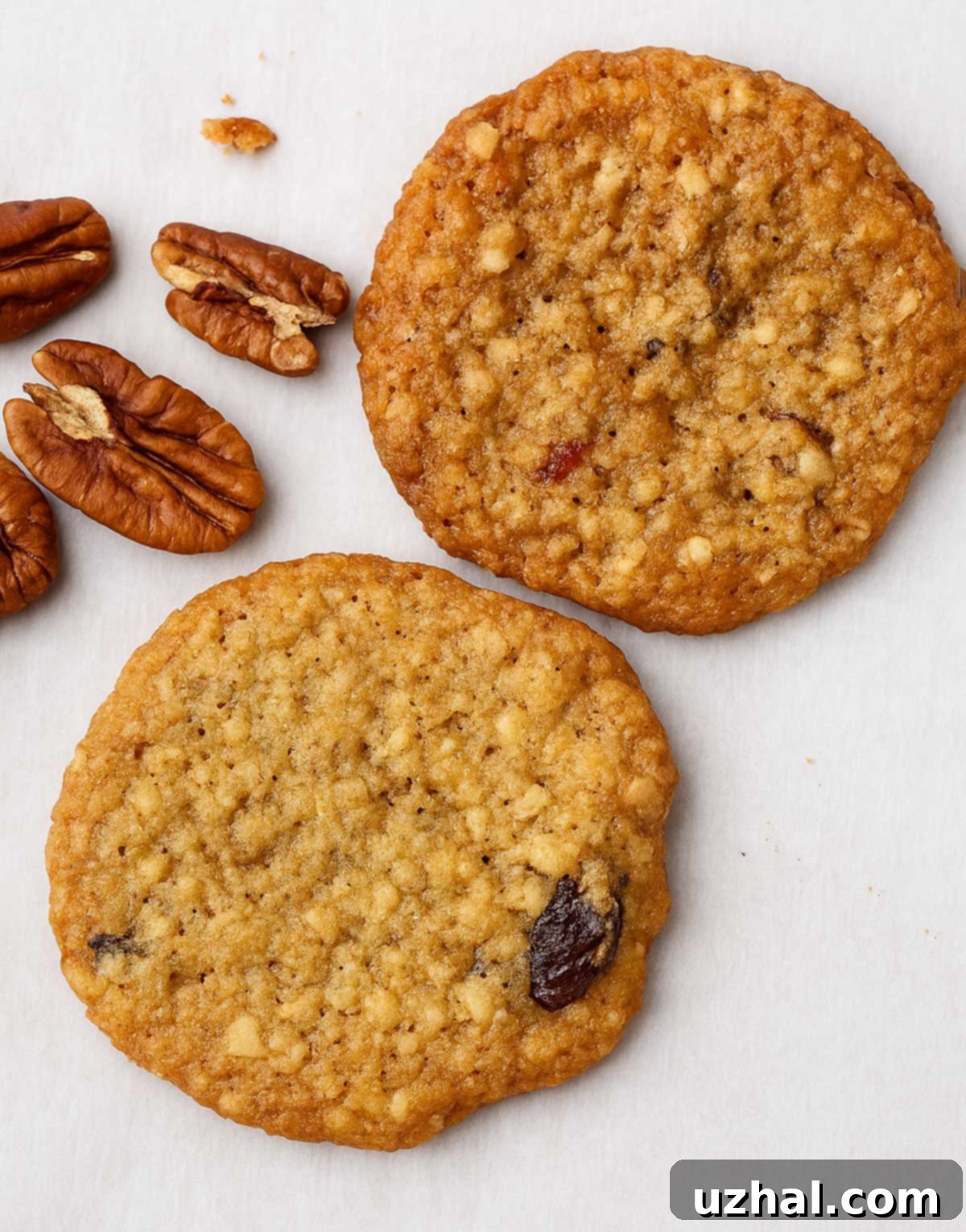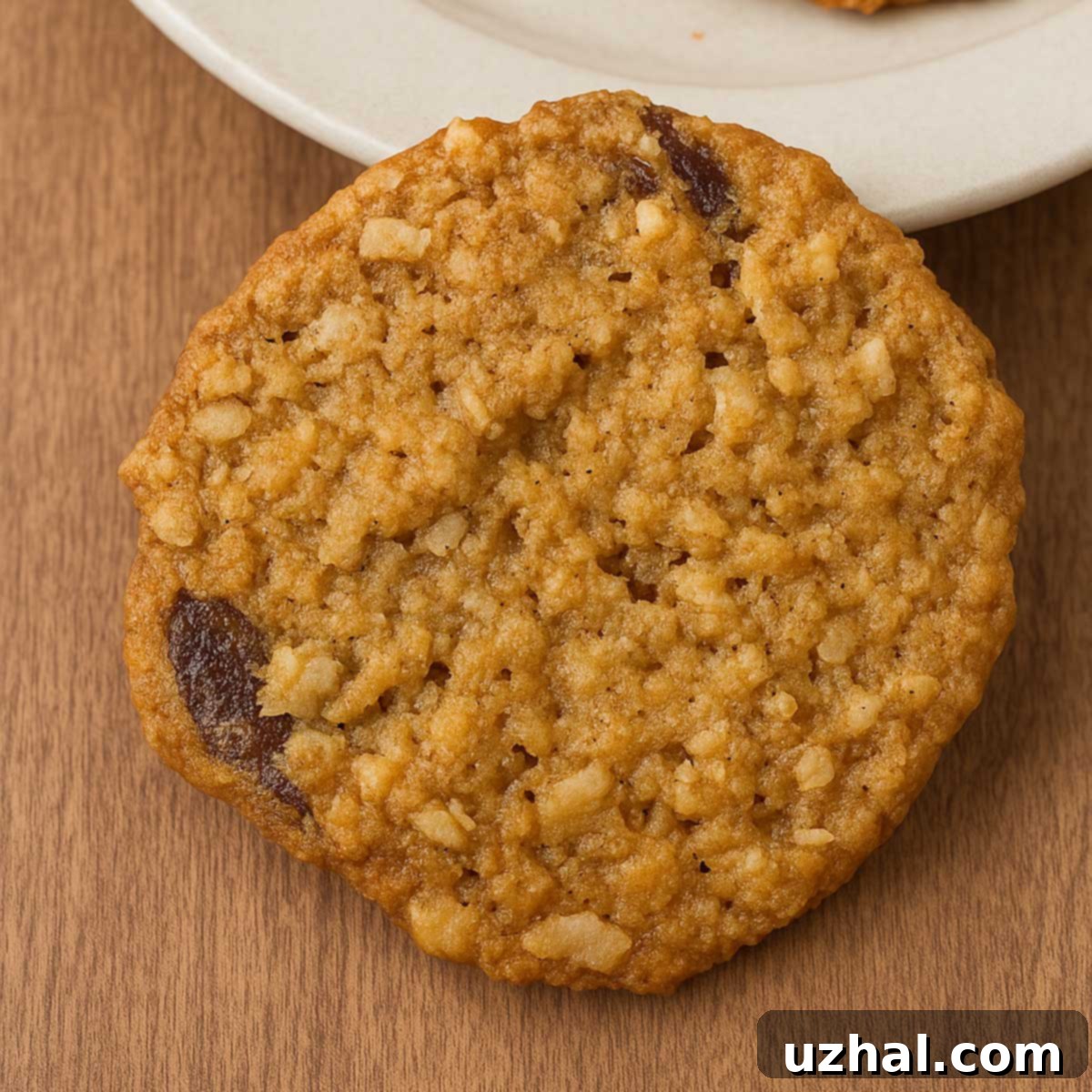Irresistibly Crunchy Oatmeal Cookies: Your Guide to Perfect Slice and Bake Honey Pecan Delights
Are you craving that satisfying snap and crumble of a truly crunchy oatmeal cookie? You’re not alone! In a world often dominated by soft and chewy cookie trends, there’s a growing appreciation for the crisp, substantial bite that only a perfectly baked crunchy cookie can offer. Whether you’re a long-time enthusiast or just discovering the joy of a crisp treat, this recipe for slice and bake honey pecan oatmeal cookies is designed to deliver maximum crunch and flavor. I recently rediscovered and refined an old favorite from 2006, updating the method and ingredients to create an even more spectacular cookie. These “slice and bake” wonders are not just a delicious trip down memory lane; they’re streamlined for modern convenience, ensuring uniform, crispy results every time. Get ready to bake a batch of these extraordinary cookies that promise both nostalgia and a delightful, snappy texture.

Unforgettable Flavor and Texture Notes: Honey, Pecans, and More
From the very first bite, these crunchy oatmeal cookies will captivate your senses with their deep, warm, and inviting flavors. The star combination here is undoubtedly the harmonious blend of rich honey and toasted pecans, which are so prominent that I almost named these “Honey Pecan Crunch Cookies.” The three tablespoons of honey in this recipe do more than just sweeten; they contribute a unique depth and a subtle floral note that elevates the entire cookie experience. Beyond flavor, the pecans also play a crucial role in the cookie’s structure, adding a delightful crunch and a robust, nutty counterpoint to the sweetness.
But the flavor journey doesn’t stop there. The dough also incorporates coconut, which lends a tropical undertone and a slight chewiness that complements the crunch. If coconut isn’t to your taste, feel free to omit it without significantly impacting the cookie’s structural integrity or overall deliciousness. For an added layer of complexity and a touch of fruitiness, consider including raisins or currants. These dried fruits pair exquisitely with the honey and pecans, providing bursts of sweetness and a pleasant textural variation. Alternatively, a handful of mini chocolate chips can transform these into a truly indulgent treat. The beauty of this recipe lies in its adaptability, allowing you to customize the add-ins to suit your personal preferences while still achieving that coveted crispy texture.

Mastering the Crunch: The Right Fat for Crispy Oatmeal Cookies
The quest for maximum crunch in an oatmeal cookie often comes down to one critical ingredient: the fat. After extensive testing, I’ve found that the ultimate crispy texture is best achieved with a precise blend of butter and trans-fat-free shortening. While butter provides unparalleled richness and flavor, shortening contributes a superior structural integrity and helps prevent excessive spreading, resulting in those desirable crunchy edges. For this recipe, I highly recommend Spectrum Organic Shortening, which is known for its neutral flavor profile and its ability to help cookies bake up evenly with a consistent crispness.
During my testing, I also tried a batch made with all butter (as seen in the cookie on the left in the top photo). The flavor, as expected, was wonderfully rich and buttery. However, the cookies tended to spread more unpredictably, and many turned out chewier rather than consistently crunchy. This illustrates the fundamental difference: butter contains water, which evaporates during baking, creating steam that can lead to a softer, more delicate crumb. Shortening, being 100% fat, melts at a higher temperature and provides a more stable structure, resulting in a crispier, snappier texture. So, if your goal is pure, unadulterated crunch, a blend of shortening and butter truly offers the best of both worlds – the beloved flavor of butter combined with the structural prowess of shortening. This strategic choice of fat is paramount in creating these perfectly crispy oatmeal cookies.
The Convenience of Slice and Bake Oatmeal Cookies
Traditionally, many oatmeal cookie recipes involve scooping and shaping individual portions of dough, which can be time-consuming and often leads to cookies of varying sizes. However, I’ve transformed this recipe into a highly efficient “slice and bake” format by rolling the dough into logs. This method offers a multitude of benefits that elevate the entire baking experience. Firstly, convenience is key; once your dough logs are prepared, you can chill them for several hours or even freeze them for future baking sessions. This means freshly baked, warm cookies are just minutes away whenever the craving strikes, without the need for extensive prep time.
Beyond convenience, the slice and bake approach ensures remarkable uniformity in your cookies. Each slice from the log will be roughly the same size and thickness, leading to consistent baking and a professional-looking batch of treats. This uniformity is especially beneficial for achieving an even crunch across all your cookies. A handy tip for shaping: if your dough slices appear a little uneven or oval after cutting, simply give them a gentle nudge with your fingers to reshape them into perfect circles before placing them in the oven. It’s a super easy trick that makes a big difference in the final presentation and ensures every crunchy oatmeal cookie is picture-perfect.
Batch Flexibility: Large Batch or Half Batch with a Crucial Half Egg
This recipe is designed to yield a generous batch of delicious crunchy oatmeal cookies, perfect for sharing, gifting, or stocking your cookie jar. However, if you’re baking for a smaller crowd or simply want to enjoy fewer cookies at a time, the recipe halves beautifully – with one critical caveat: you must use half an egg. Attempting to use a whole egg in a halved recipe will introduce too much moisture, which can significantly alter the cookie’s texture, resulting in a chewier rather than the desired crunchy outcome. To achieve the perfect half-egg measurement, simply crack one large egg into a small bowl, whisk it thoroughly with a fork, and then measure out approximately 2 tablespoons (around 24 grams) for your half batch. This small adjustment is vital for maintaining the cookie’s signature crispness.
For those exploring vegan or egg-free options, a flax egg (1 tablespoon ground flaxseed mixed with 3 tablespoons water, allowed to sit for 5 minutes) or aquafaba (the liquid from a can of chickpeas) could be viable substitutes. While I haven’t personally tested these alternatives with this specific recipe yet, they are worthy experiments for anyone looking to adapt the recipe. Keep in mind that egg substitutes can sometimes affect the texture and spread of cookies, so expect potential variations and be prepared to adjust bake times or other elements if necessary. The general principle for egg-free baking often involves careful consideration of moisture balance to preserve the desired crisp texture in your crunchy oatmeal cookies.
The Secret to Success: Measure Carefully for Crispy Oatmeal Cookies
While this recipe might be a beloved classic, like many baking endeavors, it truly shines when precision is applied. Achieving the perfect light and crispy texture for these crunchy oatmeal cookies hinges on careful measurement. I cannot overstate the importance of using a kitchen scale for accuracy, especially when it comes to flour. Cups can vary significantly in how much flour they hold depending on how it’s scooped and packed, leading to inconsistent results. A scale eliminates this guesswork, ensuring you add the exact amount needed for optimal texture.
When it comes to flour, I’ve had exceptional results using pastry flour, which has a lower protein content and contributes to a more tender, delicate crumb. However, all-purpose flour works perfectly well too, and is more commonly found in most kitchens. The key is to ensure you don’t overpack your measuring cups if you’re not using a scale. Spoon the flour lightly into the cup and then level it off with a straight edge. Remember, when you’re aiming for that light, crispy texture in your oatmeal cookies, less flour (measured correctly) is almost always more. Over-measuring flour is a common culprit for dense, tough cookies, so take the time to measure diligently, and your patience will be rewarded with perfectly crunchy results.
Perfecting the Bake Time for Ultimate Crispness
Bake time is a crucial variable in achieving that coveted crunch in your oatmeal cookies, and it can vary significantly from one oven to another. My initial tests involved baking at 350°F (175°C) for approximately 12 to 15 minutes. However, I also experimented with a slightly lower temperature of 325°F (160°C) for about 18 minutes. What I discovered is that while both temperatures can work, careful observation is key. I strongly recommend baking a small test batch first, perhaps six cookies, at 350°F for about 12 minutes.
At the 12-minute mark, check your cookies. They should be a beautiful dark golden brown around the edges and slightly firm to the touch. The color is your primary visual cue for doneness and crispness. If you pull them out of the oven too soon, while they will still be delicious, they might lack that satisfying crunch you’re aiming for, tending towards a chewier texture instead. If your test batch at 350°F turns out chewier than desired, don’t despair! This indicates your oven might run a bit hot, or the moisture content is just right for a longer, slower bake. In this case, try baking subsequent batches at a lower temperature, such as 325°F, for a slightly longer duration. This “lower and slower” approach often encourages more moisture evaporation, resulting in a crispier cookie. Always remember, trust your oven and your instincts, and adjust as needed for perfectly crunchy oatmeal cookies every time.
- Top 10 Cookies Summer 2007
- Honey Pecan Bars Without Eggs
- Crunchy Oatmeal Blueberry Pecan Cookies
- Honey Cookies for the Holidays
- Honey Blueberry Cream Cheese Bread
Recipe

Slice and Bake Crunchy Oatmeal Cookies
Anna
Pin Recipe
Equipment
-
1 Stand Mixer
Ingredients
- 1 cup pastry or all purpose flour 4.5 oz/ 126 grams
- 1 teaspoon baking soda
- ¾ teaspoon cinnamon
- ¾ teaspoon salt
- ¾ cup unsalted butter or use ½ cup shortening and ¼ cup butter (170 grams butter or use 98 grams shortening plus 56 grams butter)
- 1 ½ cup granulated sugar (300 grams)
- 3 tablespoons honey (60 grams)
- 1 tablespoon molasses (20 grams)
- 1 large egg
- 1 teaspoon vanilla
- 2 ½ cups oats, quick cooking (260 grams)
- 1 cup toasted chopped pecans (100 grams)
- ¼ cup shredded sweetened or unsweetened coconut
- ¾ cup raisins, currants or mini chocolate chips (optional)
Instructions
-
Stir together flour, baking soda, cinnamon and salt; Set aside.
-
In the bowl of a stand mixer fitted with a paddle, beat the butter and sugar until light and creamy. Scrape the sides of the bowl and add honey, molasses, egg and vanilla. Mix on low, then increase speed to high and beat on high speed for another minute.
-
Add flour mixture and stir until it’s about halfway mixed, then add the oats, pecans and coconut. With the mixer, beat on a lower speed just until dough is cohesive. It’s a fairly crumbly dough, so try to get it to stick together without over mixing. If you need to you can empty it onto a clean surface and do it by hand.
-
Divide into four sections. Shape each dough section into a cylinder about 1 ½ inches in diameter (or however wide you want the cookies) and wrap tightly. Chill for several hours or until dough is very firm.
-
Preheat oven to 350 degrees F. Line two cookie sheets with parchment paper.
-
Slice the cylinders into rounds about ⅜ to ½ inch thick. Arrange on baking sheets spacing 1 ½ to 2 inches apart.
-
Bake for about 12 minutes or until the cookies are a dark golden color; Let cool for about 3 minutes on cookie sheets then transfer to a wire rack to cool. They will crisp and firm up quite a bit as they cool.
Notes
